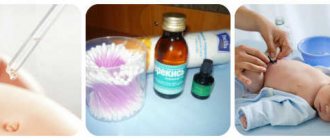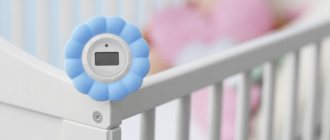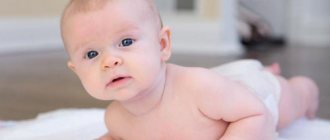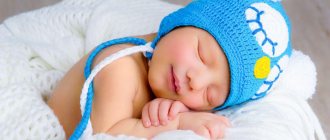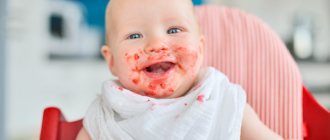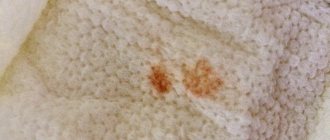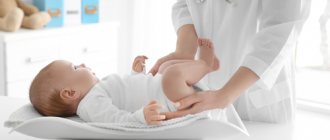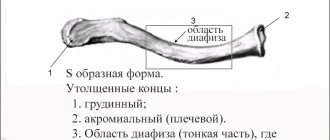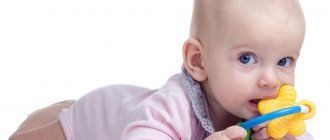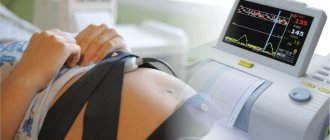Maternity hospital, the first joy of meeting the baby and family is behind us, and the time has come. This exciting moment causes fear from the first thought, especially among new parents.
With which ? It seems that everyone already knows the answers to these questions. But there remains one more important point - the use of potassium permanganate, or simply potassium permanganate. Baths with it were the most common means of hygiene in the times of our mothers and grandmothers, but recently they have begun to actively prohibit it. Let's figure out whether potassium permanganate is needed for bathing a newborn or whether it still causes harm.
For new parents, a newborn baby is a fragile creature who will be in fear. Undoubtedly one of the greatest tests of self-control and calm for mother and father, however, remains the little person's first bath. That's why today we decided to introduce some of the biggest misconceptions that make this process a pleasant ritual for a real stress for the whole family.
A newborn should bathe only with boiled water
According to most pediatricians, the most common tap water should be used to bathe a newborn. The child does not need such a high level of infertility. The only thing to remember is that it is good to be careful not to get the umbilical cord wet. And for the rest of us, don’t complicate your life with annoying daily boiling water. Your child doesn't need it, yours does.
About potassium permanganate
Potassium permanganate (chemical formula KMnO4) or potassium permanganate
is a common chemical with a huge number of useful properties.
It has a powerful disinfecting effect
and is used in medicine. Previously, it was sold in any pharmacy at low prices in powder form. Now, for many reasons, it is sold mainly by prescription.
You need to add potassium permanganate to the water
The antiseptic effect of such a soft solution tends to zero, and not to disinfection. Be aware that potassium permanganate dries and stains the skin, is easy to overdose on, and even a very weak solution can cause chemical burns if it gets in the eyes.
The water temperature must be at least 37 degrees
The idea of the bathroom, aside from washing your baby, is to get the little creature to relax and fall in love with the experience itself, so don't try to cook it in water. However, your newborn's skin has nothing to do with this!
Used in a variety of cases:
- For disinfecting and drying wounds;
- Destroys most microbes, preserving beneficial microflora;
- When used correctly, it is harmless even for newborn children;
- Can be used for a long time;
- Not addictive;
- Is an anesthetic;
- Helps in wound healing;
- Dries out the skin.
The last point often causes controversy among many mothers and even some doctors, since the delicate skin of babies
on the contrary, it should be moisturized more often.
In addition to general drying of the skin, a solution of potassium permanganate
also
cures diaper rash and dermatitis
, which, on the contrary, is a positive effect.
Be careful when bathing does not go into your baby's ears so you don't get ear infections
Although it sounds possible, water cannot get into the Eustachian tube, which is the cause of otitis media in infants. The person responsible for this problem is a runny nose. However, it is best to protect your baby's ears from the spray of water, especially when you are washing your hair. It is enough to keep your hand wet and very gentle to wash your ear. The only body parts that should not be submerged in water are your baby's nose and mouth.
Newborns should only bathe in the evening and before bed
This is true, but only to a certain extent. It is believed that after bathing, babies relax and are better able to eat and sleep. But there are some children who become more agitated and do not want to eat or sleep. If you suspect yours is one of these, postpone the procedure until the morning or early afternoon. There is no point in bathing your baby at night if it is not beneficial for his nervous system and the peace of the whole family.
Manganese baths
necessary for children in the first days of life, as they will help with healing and help avoid rotting and getting wet.
To avoid harm to the newborn while bathing in manganese
, you need to dilute it correctly and use it according to your doctor’s instructions.
In this case, the benefits of washing in potassium permanganate
will be obvious.
Pediatricians recommend using special aids for infants, but not more than 1-2 times a week. Although your baby is not as active, you don't need to use them often. This does not apply to the washing procedure, which is performed under running water and special baby soap or body gel.
What causes atopic dermatitis? The phyla gene mutation prevents the skin from not being protected by the skin. This may predispose to the development of atopic dermatitis, since the poor structure of the epidermis allows allergens to penetrate and contact cells of the immune system. The epidermis loses its building blocks - ceramides. It begins to resemble a filter through which everything goes to the center. This is not indifferent to the body - after all, the skin's job is to protect the body from external factors.
How to dilute potassium permanganate for bathing
And now the newborn is about to have his first bath with potassium permanganate. How to properly dilute potassium permanganate for bathing a newborn?
The solution of potassium permanganate should always be diluted fresh for bathing, and under no circumstances should potassium permanganate crystals be thrown directly into the bath. Crystals that are not completely dissolved can cause chemical burns to delicate skin. To prepare a solution of potassium permanganate for bathing a newborn in the correct proportion, you need:
- Pour 5-7 potassium permanganate crystals into a clean glass;
- Pour hot boiled water and stir until completely dissolved. Manganese will not dissolve in cold water. The liquid acquires a bright purple color;
- Be sure to strain the diluted solution through gauze folded in several layers. And evaluate the solution against the light, checking whether there are any undissolved crystals left;
- Pour the prepared solution into the previously prepared bathing water and stir until the water becomes evenly pink.
How much potassium permanganate is needed for bathing a newborn
To take a bath with potassium permanganate
has produced the necessary and beneficial effect, it is necessary:
- Take 5-7 grains of potassium permanganate (as a rule, the grains are quite large, so this amount is enough);
- In a transparent glass (this is mandatory), dilute these grains with boiling water (at least 95 degrees);
- Stir the resulting solution thoroughly until it turns bright pink (or transparent purple);
- If undissolved grains are found in the glass, it is necessary to stir the solution even more thoroughly;
- If in doubt, it is best to use gauze or a very thin cloth and pour the finished mixture through it. This will allow you to retain undissolved grains and avoid possible burns;
- The prepared fresh solution of potassium permanganate is poured into the bath prepared for the baby and distributed evenly so that all the water is colored pinkish.
After which you can immerse the baby in water and not be afraid of germs and problems during bathing
.
So it's mostly a genetic disease? Part of it is genetic, but also part of civilization. It is very possible that all these disturbances in the epidermis are also caused by environmental influences. Why are more people suffering from atopic disease now?
There was a theory that the subconscious, which is not very strong, but constant exposure to harmful substances, small detergents used in children, causes a weakening of the lipid layer of the epidermis, and it further affects the immune system, stimulating it. And immunology again affects this lipid layer and produces the lower wheel. In conditions of civilization, allergies are certainly more frequent. So genetics, but also environment.
How to prepare a solution of potassium permanganate
How to properly dilute potassium permanganate for bathing a baby?
You cannot throw potassium permanganate granules directly into the bathtub ; undissolved particles may cause a burn if they come into contact with the skin or mucous membranes.
Before preparing for bathing, a solution of potassium permanganate is prepared in a separate container by adding several granules of the substance to a glass of hot boiled water.
The color of the resulting concentrated solution should be rich, pink-violet.
The resulting mixture is then filtered through a gauze filter to prevent the entry of whole particles.
The colored solution is poured into the prepared water in the bathroom, which should acquire a light pink color. Then the bathing process itself begins.
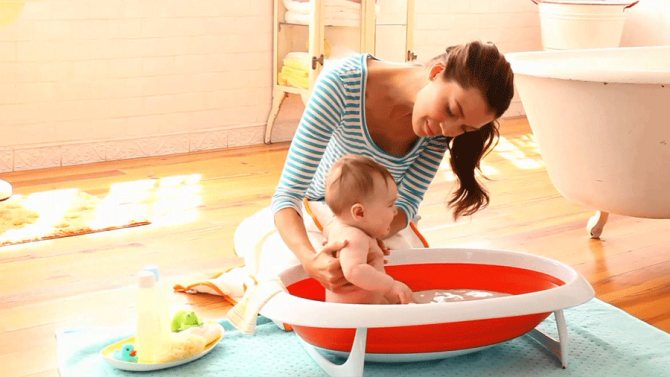
Contraindications and harm
Of course, potassium permanganate
, like any chemical (non-natural) substance, it has a list of contraindications and can cause harm if used incorrectly:
- Grains of potassium permanganate that have not completely dissolved can cause a burn to the eye or even skin upon contact;
- You should not allow your child to swallow such water - it can cause food poisoning;
- During constant bathing, the skin may turn brown (just like the towel in which the baby is wrapped).
Potassium permanganate for bathing newborns
Quite often you can hear that parents bathe their children in potassium permanganate. Our mothers and grandmothers knew about this method. After all, before there was no such abundance of modern, affordable and safe means.
Potassium permanganate is used to disinfect the water in which the baby will wash. It is advisable to use it in the first 2-3 weeks after the birth of the baby. That is, until the belly button heals.
Modern pediatricians do not see the need to use potassium permanganate. After all, a weak solution is used for bathing, which does not have the desired effect. If you make it more concentrated, you can expose the baby’s dermis to burns.
A very important point in using this substance is the preparation of the solution. If this is done incorrectly, the baby may get burned.
How to dilute potassium permanganate for bathing a newborn:
- Dilute 1/10 of a teaspoon of potassium permanganate in a glass of boiled water;
- Mix well. The solution will have a purple or bright crimson color;
- Strain through cheesecloth (so crystals that have not dissolved will remain on the surface of the gauze);
- Pour the prepared solution into a bath of water, move well, and only then immerse the child in it.
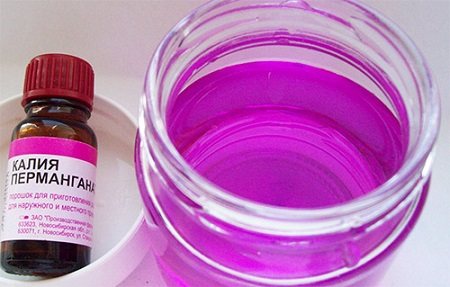
When not to use potassium permanganate
Use of potassium permanganate
not recommended if:
But the environment can also influence genes that already exist in our lives. There is a phenomenon of epigenetics, that is, the influence on genes of what happens outside the body throughout our lives. Our genes do not work according to the recipe that we created in our concept. Their activity changes - some are turned on, others are turned off under the influence of environmental factors. No one has written this directly, but in my opinion it is up to interpretation.
What are “normal allergies” and what is atopic dermatitis? The difference is that atopic dermatitis is not direct, and usually no one can find the allergen that causes the disease. Moreover, this does not guarantee that its removal will improve the patient's condition!
- The baby has skin damage (cracks, scratches, wounds);
- The umbilical wound is overgrown;
- Diaper rash is brought to a bleeding state;
- The skin is very dry and flaky.
In any case, the use of potassium permanganate
It’s best to discuss it with a leading pediatrician - he will tell you exactly how harmful or beneficial its use will be.
Contact allergies are easy. If we find an allergen that a patient is allergic to, such as nickel, and that person doesn't interact with it, that would be great. There's no room here. People do hundreds of tests, like skin tests on small children or blood tests for allergy sensitivity, which don't make any sense!
Among others, there are emollients. ceramides, cholesterol, free fatty acids and various moisturizers such as urea, glycerin and amino acids, which improve skin barrier functions, reduce transepidermal water loss. Ceramics-rich preparations have anti-inflammatory properties that are comparable to topical highly effective glycocorticosteroids, and lycopalbumin A is active in hydrocortisone. Propylene glycol and emollients containing white allergens and haptics should not be used in children under two years of age due to their immature and very sensitive skin.
It is worth remembering that with proper dilution of potassium permanganate
The benefits of it during the baby’s first baths will be obvious.
Analogs
If you are still afraid to use potassium permanganate during your first baths
, or it is prohibited for the baby for some reason - do not despair.
You can always find a suitable “folk” remedy to replace it.
Best for infants in terms of disinfecting effect. This herb has many beneficial properties and is approved for use from the first days of life. You can also bathe your baby using or. They have a powerful antibacterial effect and are practically harmless (if used correctly and without allergic reactions). Or simply bathe the child in a clean bath beforehand - this will also protect against possible infections.
Intensively moisturizing the skin of premature babies has been shown to reduce their mortality. Emollients restore the function of the epidermal barrier, prolong the period of remission and can significantly reduce the use of topical anti-inflammatory drugs necessary to combat inflammation.
If your skin is irritated, avoid sodium lauryl sulfate in soap. The duration of the bath should not exceed five minutes, and adding water to the end of the bath with olive oil or paraffin softens the epidermis and strengthens the lipid barrier to the skin. For better anti-inflammatory effects, it is recommended to add sodium hypochlorite to the bath. It may also be helpful to add antiseptics to the bath, which limit the colonization of the skin by staph superantigens, increasing skin inflammation.
IMPORTANT!
Remember that before bathing your child in herbal infusions, check for allergic reactions to herbal infusions or herbal infusions! At the slightest suspicion of an allergy, wash off the allergen with plenty of running water and consult a doctor.
If you still decide to bathe your child with the addition of potassium permanganate
– don’t forget about hydration and enjoy your healthy baby.
Avoid harsh and heavy rubbing with the towel. It is essential that the skin heals quickly, that is, within three minutes of the end of the bath, to prevent evaporation and drying of the epidermis. The soaked BandaS is applied to the skin immediately after the patient's bath, preferably in the evening, when the pain is especially intense and makes it difficult to fall asleep. The use of a double layer of bandage causes a cooling effect. Skin and skin moisturizers are anti-inflammatory and are effective in reducing inflammation and accelerating eczema.
Hydration, as well as occlusion through dressings, simultaneously increase the percutaneous absorption of the drug. The moisturizing ingredients contained in emollients better and more effectively complement imperfections in dry atopic skin, which restores the skin barrier and reduces inflammation.
One of the pressing issues regarding the care of a newborn is the issue of the use of potassium permanganate
while swimming.
Our grandmothers also passed down the firm belief that this remedy is necessary for drying the soft and unprotected skin of a baby.
, but modern doctors do not recommend using it due to the threat of
burning your child’s eyes
.
In the not-too-distant past, the natural process of removing water from the body through transpiration was believed to be a sign of good health. In 19th century Russia, for example, a wedding in a noble family was organized only after careful study of the bride. The groom's female relatives took her to the sauna, where they bathed together, observing two significant things: if the girl did not have any physical disabilities, and if she sweated normally. It is believed that women who do not sweat cannot give birth to healthy children.
But there is no such thing as excessive sweating. The skin is the body's largest organ and protects us from invading pathogens in the environment, so we must be careful not to become dehydrated or too wet. The fight against sweating - sweating is a long-term problem, since it is closely related to the diseases that it causes: hormonal disorders, tuberculosis, diabetes, syphilis, keratoderma, flat feet, rheumatism, excess weight, neurasthenia, neurovegetative system imbalances. If you have not yet identified the cause of your sweat, although the problem bothers you and becomes unbearable, try to solve it, at least partially, with natural methods.
Knowing that some parents resort to using potassium permanganate to rinse the baby’s stomach, experts strongly advise against this method
, arguing this with the same danger of getting burned, which happens quite often.
In such a situation, parents rush between two fires. It would seem that there is nothing more useful than caring for a child according to folk recipes, but, on the other hand, the fear of harming the baby stops the spouses.
Breathing in one nostril In summer, at high temperatures, it is recommended to use breathing in one nostril. Breathing through the left nostril slightly cools the body, while the right nostril warms it up. We can close the right nostril with a cotton swab and slowly breathe to the left, pushing through the lip, with a little effort to train the diaphragm and the entire respiratory system. The body, so cooled, does not sweat much.
Pumpkin Paste The elders still knew the natural method. The entire freshly brewed plant, with flowers and roots, is cleaned of dry parts, cut off into regular pieces and the juice is squeezed. In the jar, the juice is combined with the remaining residue after squeezing, and brandy is poured over it to cover with about three fingers. The hermetically sealed jar is placed in macerate in the dark for 5-7 days. Areas that sweat excessively are wiped with a sponge soaked in lotion.
Of course, everyone is free to decide for themselves what to believe and who to follow, so it makes sense to talk about the positive aspects of using potassium permanganate
during bathing, and about negative ones. And parents will draw conclusions themselves, without anyone’s help or interference.
It is believed that this remedy has a unique ability to eliminate inflammatory processes in the genitourinary organs, fight skin ailments, and cure hemorrhoids
at the baby's.
Birch bud tincture For all areas of the body that sweat profusely, use a tannery with birch bud tincture. Rub clay powder thoroughly onto soles, palms or swabs before bed or soak in socks or cotton gloves for 10 days.
If necessary, the procedures are repeated monthly. Beer Baths To reduce sweat, local ancestors and local beer are used to add beer. A liter of beer is poured into a half-filled bathtub, and for the palms or soles of the feet, they are made in a bowl with a glass of beer. To get a quick therapeutic effect, take a daily bath for 14 days. Those who suffer from abnormal sweat should have their potassium permanganate, crystals or concentrated solution in their medicine kit to add to the herbal infusions used for topical baths.
It helps both adults and children well. Usually, when seeing a young mother off from the maternity hospital, female midwives are advised to turn to potassium permanganate in the first days
and weeks of the baby’s life, arguing that baby baths with dissolved powder help to quickly tighten the navel and prevent
dangerous bacteria
.
The main thing you need to pay attention to when using the product is that it should never be dissolved by pouring it directly into the bathroom. The solution should be prepared separately and then added to the water.
Otherwise, the crystals can cause burns to the child, because his skin is still so sensitive in the first stages of life.
.
